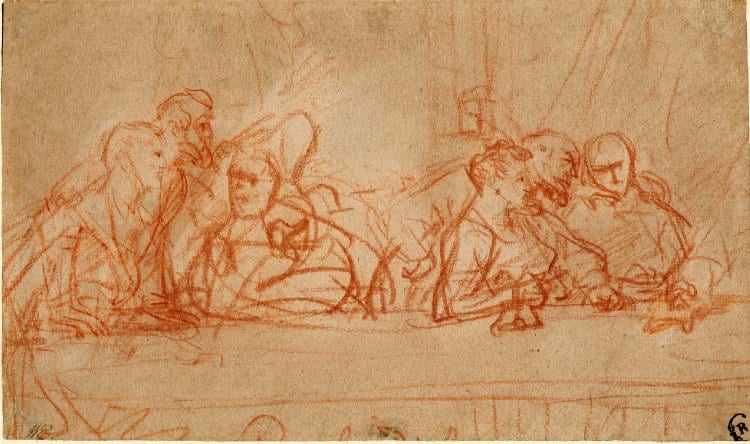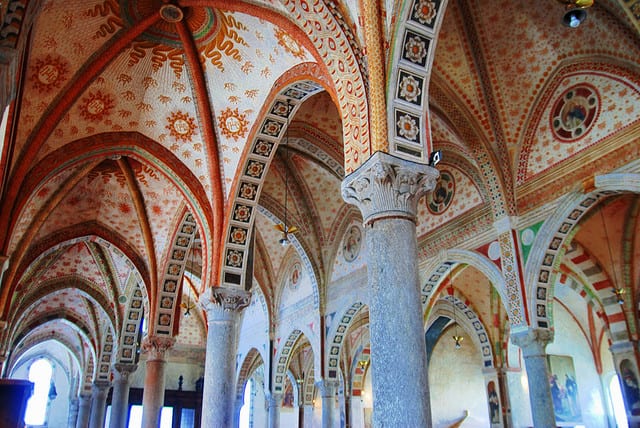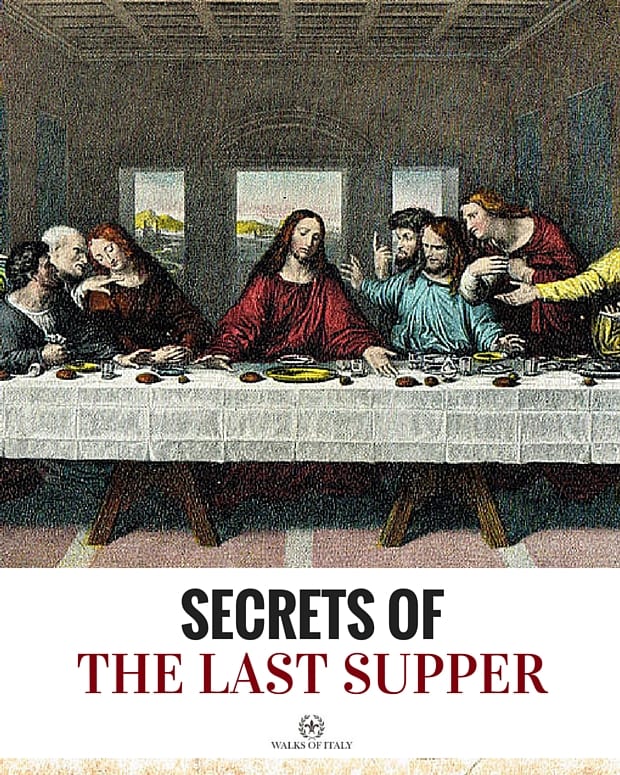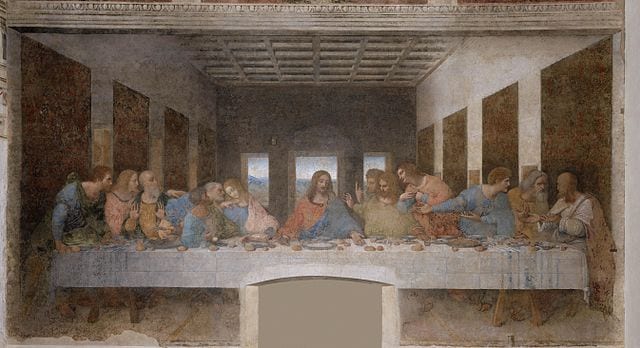
8 Fascinating Facts You Didn’t Know About Da Vinci’s Last Supper
February 16, 2023
The Last Supper by Leonardo Da Vinci is a masterpiece of Italian Renaissance art. Finished in 1498, the wall painting is still available to see in person at Santa Maria delle Grazie in Milan. There are a lot of amazing things to do in Milan, but seeing da Vinci’s Last Supper is definitely a highlight. The enormous picture (it’s 15 feet by 29 feet) paints the moment right after Jesus declares to his twelve apostles that one of them will betray him – right down to the individual expressions on each apostle’s face! Da Vinci’s Last Supper is so famous that you’ve probably seen a copy more than a few times, but how much do you really know about the masterwork? Here are 8 facts that will probably surprise you:
Table of Contents
ToggleThe Last Supper is not a fresco
Though it is a wall painting, da Vinci invented a new method to complete the Last Supper.
Da Vinci needed time to work on the Last Supper, time which fresco painting doesn’t allow. In a fresco, tempera has to be added quickly before the plaster dries, forcing an artist to work quickly and making it very difficult to make changes. Instead, da Vinci decided to add tempera to already dry plaster, allowing him to work slowly, develop the shading that comes with the chiaroscuro of the mural and make any changes necessary over time. He did this by coating the wall with a material that absorbs the oil paint and protects it against moisture. While it did allow him to paint as he wished, the paint began to break loose from the base coat as early as 1517 – just about two decades after he began. As a result da Vinci’s Last Supper has suffered changes in temperature, moisture and humidity more than most frescoes.
Leonardo got inventive to nail the painting’s perspective
Leonardo da Vinci’s Last Supper is particularly incredible for the perspective the great artist successfully employed. Arguably the best example of one point perspective in the world, every single element of the painting directs attention directly to Christ’s head, right in the middle of the composition. Da Vinci accomplished this by driving a nail into the wall at Jesus’ temple, the exact focal point of the painting. From the nail, he radiated string in various directions to help him see the room’s perspective and paint the other elements in the piece in a way that led the eye back to Christ.
The downside of this setup was that it forced da Vinci to depict some of the disciples somewhat thanklessly from behind. This went against Leonardo’s desire for an expressive characterization of each of the twelve Apostles. But a circular table would not provide adequate opportunity for exploiting the dramatic element of the scene.
The Last Supper is not just art, but math as well
An engineer and inventor, Leonardo was well known for using math in all of his works and that includes his paintings. Da Vinci’s peer, Luca Pacioli, once wrote in De Divina Proportione (On the Divine Proportion), “Without mathematics there is no art.” In fact, da Vinci supplied the illustrations for that book. Da Vinci’s drawings show that most bodily proportions use the Golden Ratio, a mathematical way to decipher artistic proportion.
Besides the Golden Ratio, many say that there is mathematical symbolism in the Last Supper as well. There are allusions to the number 3, likely representing the Holy Trinity. The disciples are seated in groups of three, there are three windows and Jesus is depicted in a triangle shape with his outstretched arms.
He likely used familiar faces – maybe even his own
Most accounts claim that da Vinci’s Last Supper uses the faces of actual people to stand in for the apostles’ faces. It’s said that he loitered around jails and with Milanese criminals to find an appropriate face and expression for Judas, the fourth figure from the left and the apostle who ultimately betrayed Jesus.
He might have even painted himself in the wall mural! Though it’s never been proven, some art historians say that da Vinci painted his own likeness as that of St. James the Less. Either that, or the apostle looked a lot like the painter!
Two other copies exist
The Last Supper was a popular theme to play on for artists and Catholics of the time and has been painted many times by other artists. However, two early, exact copies of da Vinci’s Last Supper are known to exist. Likely created by Leonardo’s assistants, the copies are nearly the exact size and likeness of the original and are remarkably well preserved. One copy can be found in the collection of the Royal Academy of Arts in London and the other in the Church of St. Ambrogio in Ponte Capriasca, Switzerland.
Each figure serves a specific purpose, and creates a very emotional whole
Da Vinci’s Last Supper was certainly not the first painting of the famous biblical scene, but it changed the scene partly for the apostles’ specific expressions and the intimate feeling that they create. Bartholomew, James the Less and Andrew are all shocked by Christ’s proclamation, and Andrew has his hands up to stop the words. Judas, Peter and John form the next group of three. Peter is angry and John seems faint, but Judas has his face in the shadow. In the past Judas was painted separated from the group off to the side. Instead, Leonardo paints Judas among the group, but lost from Christ’s light – literally – as he is covered by a shadow. After Christ is Thomas, James the Greater and Philip, each agitated, stunned or confused, respectively. Matthew, Thaddeus and Simon form the last three, with the first two looking to the latter for an explanation.
Christ, on the other hand, represents calm in the face of chaos. As the apostles run the gamut of emotions, Christ is in the center of the storm, calm and expansive, providing both a perspective and emotional anchor for the scene. The objects around Christ have fallen over, representing the chaos when he is not around, while those in front of him are orderly. With his arms spread out, possibly representing the Holy Trinity, he is pointing to the bread and wine before him, each a symbol of the moment Jesus will sacrifice himself.
Da Vinci believed in emotional realism in his work, and The Last Supper captures just that. It’s an electric, human and emotional scene, and it was meant to be that way.
Today’s mural might be significantly different to da Vinci’s original work

The Last Supper is located in the monk’s dining hall of the beautiful Santa Maria delle Grazie, in Milan. Photo by Francesco Sgroi
Leonardo da Vinci’s new method for mural painting was not a success in terms of longevity. The Last Supper began to deteriorate almost instantly. Over the years da Vinci’s Last Supper has been restored more than once. The most recent restoration took years and is very controversial in the art world, with some saying it is a grand success and other’s saying it has ruined the integrity of the piece, namely because it removed earlier restorations. Painted by Pinin Brambilla Barcilon, many are upset with her use of watercolors and her decision to fill in gaps with the bright watercolor paint.
James Beck, Art History Professor at Columbia University in New York, has said that the Last Supper remains just 20 percent Leonardo and 60 percent the work of the restorer. Though the outline remains, we can’t truly know how similar the current painting is to da Vinci’s original masterpiece.
It’s still being studied today, and we don’t have all the answers
There are dozens of hypothesis, conspiracies and myths surrounding da Vinci’s Last Supper, many of which can be read in the popular Dan Brown novel, The Da Vinci Code. There are also dozens of real facts that we just don’t have about the celebrated painting. Why did he choose those particular foods? Why is the bread leavened? Why is Judas’ plate empty? It’s true that da Vinci often included symbols and commentary in his artwork, but without any written records, we just can’t be sure.
More information:
For an extensive guide on how to see da Vinci’s Last Supper check out our blog post.
Tickets cost €6.50, but the only way to get one is by booking online months – and we mean months – in advance. There is an additional €1.50 booking fee. Or make the most of your time and skip the line to see the Last Supper, climb to the Duomo’s rooftop and tour the hip Brera neighborhood on our Best of Milan Tour. It’s open to the public from 8:15 a.m. to 7 p.m. Tuesday through Sunday.
Piazza Santa Maria delle Grazie 2, Tel. +390 2 9280 0360.

by Gina Mussio
View more by Gina ›Book a Tour

Pristine Sistine - The Chapel at its Best
€89
1794 reviews

Premium Colosseum Tour with Roman Forum Palatine Hill
€56
850 reviews

Pasta-Making Class: Cook, Dine Drink Wine with a Local Chef
€64
121 reviews

Crypts, Bones Catacombs: Underground Tour of Rome
€69
401 reviews

VIP Doge's Palace Secret Passages Tour
€79
18 reviews

Legendary Venice: St. Mark's Basilica, Terrace Doge's Palace
€69
286 reviews










